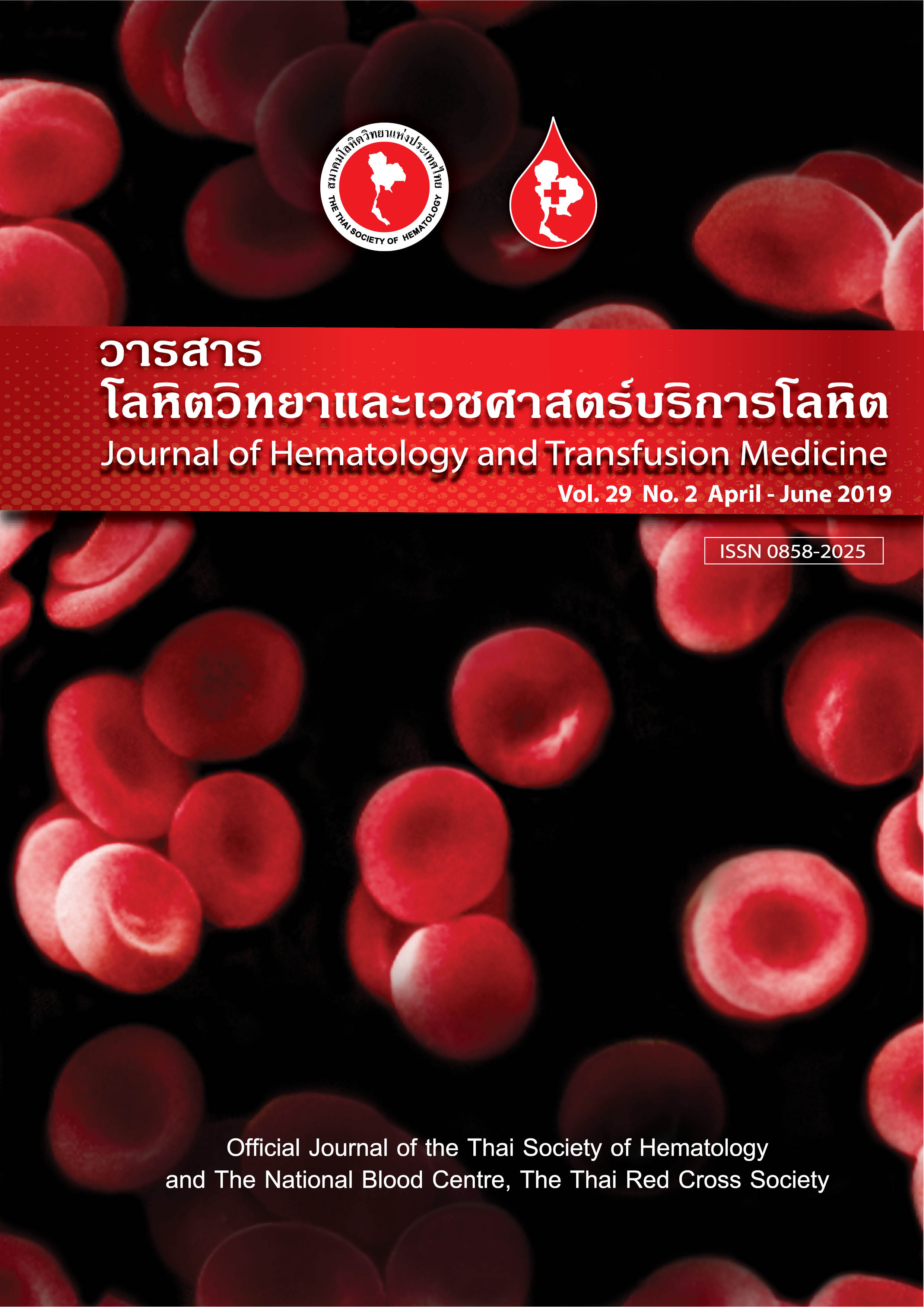Essential composition of blood products: what is different in platelet concentrate and pooled leukocyte poor platelet concentrate?
Keywords:
เกล็ดเลือดเข้มข้น, เกล็ดเลือดเข้มข้นชนิดรวมถุงที่มีจำนวนเม็ดเลือดขาวต่ำ, การควบคุมคุณภาพ, Platelet concentrates, LPPC, Quality controlAbstract
Abstract:
Platelet product is used for therapeutic purpose, so the quality control is essential for the blood bank to monitor our products because the amount of platelets in the final product is essential for the clinician to calculate the suitable dosages for treatment. There are several variables in production methods that affected the platelet yield. Objective: To study the quality of platelet concentrate (PC), pooled leukocyte poor platelet concentrate (LPPC) and 4-unit- pooled platelet concentrate (PPC) prepared by Siriraj Hospital. Materials and Methods: Two hundred and ten units of PC, 200 LPPC and 200 PPC were tested for platelet count, leukocyte count and red cell count. The volume was measured from the calculated weight. The pH was performed at day 5 of storage. Results: The average number of platelets were 8.8 x 1010+2.2, 3.1 x 1011+0.5 and 3.5 x 1011+0.3 in PC, LPPC and PPC, respectively. The average number of leukocyte were 0.14x109+2.2, 0.08 x109+0.06, and 0.31x109+0.7 in PC, LPPC and PPC, respectively. The pH at day 5 were 7.18+0.57, 7.62+0.11, 7.13+0.19 in PC, LPPC, and PPC, respectively. Conclusion: These platelet products tested met all standard requirement of the National Blood Centre, Thai Red Cross Society (NBC TRCS). Since the number of platelets in each product type was higher than the allowable limits, therefore we use a pool of 4 PC instead of 6 PC to provide platelets for an adult who weights 60 kg. However, an appropriate proportion of platelet cells and plasma volume is essential to maintain appropriate pH which is one of the quality control parameters as guided by European Directorate for the Quality of Medicines & HealthCare (EDQM).
บทคัดย่อ
ผลิตภัณฑ์เกล็ดเลือดเป็นส่วนประกอบของเลือดที่มีปริมาณการใช้อย่างมากในการรักษาผู้ป่วย การตรวจสอบคุณภาพผลิตภัณฑ์จึงเป็นหน้าที่สำคัญประการหนึ่งของธนาคารเลือด เพื่อให้ได้ข้อมูลเรื่ององค์ประกอบในผลิตภัณฑ์เกล็ดเลือด สำหรับให้แพทย์นำไปใช้ประโยชน์ในการสั่งการรักษาได้อย่างเหมาะสม การผลิตผลิตภัณฑ์เกล็ดเลือดมีได้หลายวิธี จึงทำให้ส่วนประกอบต่างๆ ในผลิตภัณฑ์ที่ได้มีความแตกต่างกัน วัตถุประสงค์ ศึกษาผลิตภัณฑ์เกล็ดเลือด ที่ผลิตโดยวิธี platelet rich plasma (PRP) และ buffy coat (BC) เพื่อนำข้อมูลไปใช้ในทางคลินิกให้แพทย์สามารถสั่งการรักษาได้อย่างถูกต้องและเหมาะสม วัสดุและวิธีการ ตรวจคุณภาพของเกล็ดเลือดเข้มข้น (platelet concentrates: PC) ซึ่งเจาะเก็บเลือดในระบบถุง Triple bags และปั่นแยกด้วยวิธี PRP เกล็ดเลือดเข้มข้นชนิดรวมถุงที่มีจำนวนเม็ดเลือดขาวต่ำ (pooled leukocyte-poor platelet concentrates: LPPC) ซึ่งเจาะเก็บเลือดในระบบ quadruple bag:top-bottom system และปั่นแยกโดยวิธีBC และเกล็ดเลือดเข้มข้นชนิดรวม PC 4ถุง (pooled platelet concentrates :PPC) จำนวน 210, 200 และ 200 ยูนิตตามลำดับ โดยวัดปริมาตร จำนวนเกล็ดเลือด จำนวนเม็ดเลือดขาว จำนวนเม็ดเลือดแดงในวันที่ 1 และวัด pH ในวันที่ 5 และทำการเปรียบเทียบคุณภาพระหว่าง LPPC และ PPC ผลการศึกษา ใน PC, LPPC และ PPC มีจำนวนเกล็ดเลือด 8.8 x 1010+2.2, 3.1 x 1011+0.5 และ 3.5 x 1011 +0.3 มีจำนวนเม็ดเลือดขาว 0.14x109+2.2, 0.08 x109 + 0.06 และ 0.31x10+0.7 สำหรับค่า pH เมื่อเก็บไว้ถึงวันที่ 5 มีค่า 7.18+0.57, 7.62+ 0.11, และ 7.13+ 0.19 ตามลำดับ สรุป ผลิตภัณฑ์เกล็ดเลือดที่ทำการประเมิน มีคุณภาพตามเกณฑ์มาตรฐานของศูนย์บริการโลหิตแห่งชาติ ซึ่งกำหนดให้ LPPC อย่างน้อยร้อยละ 90 มีจำนวนเกล็ดเลือด >2.4x1011 เซลล์ต่อยูนิต จำนวนเม็ดเลือดขาว < 0.2 x109 เซลล์ต่อยูนิต และ pH > 6.2 เนื่องจากปริมาณเกล็ดเลือดในPCสูงกว่าเกณฑ์มาตรฐาน ดังนั้นโรงพยาบาลศิริราชจึงนำไปปรับการผลิต PPC จากเดิมใช้การรวม PC 6 ถุง เป็นการรวม PC เพียง 4 ถุง สำหรับผู้ป่วยที่น้ำหนักตัวมากถึง 60 กิโลกรัม อย่างไรก็ตามในการผลิตควรระวังให้มีสัดส่วนจำนวนเกล็ดเลือดเหมาะสมกับปริมาตร เพื่อป้องกันการลดต่ำลงของ pH ด้วย
Downloads
References
2. Estcourt LJ, Stanworth SJ, Doree C, Hopewell S, Trivella M, Murphy MF. Comparison of different platelet count thresholds to guide administration of prophylactic platelet transfusion for preventing bleeding in people with haematological disorders after myelosuppressive chemotherapy or stem cell transplantation. Cochrane Database Syst Rev. 2015;11:CD010983. doi: 10.1002/14651858.CD010983.pub2.
3. Siriboonrit U, Permpikul P, Meesamat W, Kladed S, Kanpai P. Essential composition of blood product: what is different in a unit of red cell products J Hematol Transfus Med. 2018;28:25-33.
4. National Blood Centre, Thai Red Cross Society. Standards for blood banks and transfusion service. 4th ed. Bangkok: Udom Suksa; 2015. p 17-28.
5. Wagner SJ. Whole blood and apheresis collections for blood components intended for transfusion. In: Fung MK, Eder AF, Spitalnik SL, Westhoff CM, editors. Technical manual. 19th ed. Bethesda, MD: American Association of Blood Banks; 2017. p. 125-154.
6. Component monographs part C. Platelet components. In: European Directorate for the Quality of Medicines & HealthCare. Guide to the preparation, use and quality assurance of blood components.19th ed. Strasbourg: Council of Europe; 2017. p. 325-374.
7. Fijnheer R, Pietersz RN, de Korte D, Gouwerok CW, Dekker WJ, Reesink HW, et al. Platelet activation during preparation of Platelet concentrate: a comparison of Platelet rich plasma and the buffy coat methods. Transfusion. 1990;30:634-8.
8. Hirosue A, Yamamoto K, Shiraki H, Kiyokawa H, Maeda Y, Yoshinari M. Preparation of leukocyte poor blood components using a quadruple bag system. Transfusion. 1988;28:261-4.
9. Lozano M, Estebanell E, Diaz-Ricart JCM, Mazzara R, Ordinas A, Escolar G. Platelet concentrates prepared and stored under currently optimal conditions: minor impact on platelet adhesive and cohesive functions after storage. Transfusion. 1999;39:951-9.
10. Dijkstra-Tiekstra MJ1, Kuipers W, Setroikromo AC, de Wildt-Eggen J. Platelet capacity of various platelet pooling systems for buffy coat-derived platelet concentrates. Transfusion. 2008;48:2114-21.
11. Aubron C, Flint AW, Ozier Y, McQuilten Z. Transfusion of stored platelets: balancing risks and product availability. Int J Clin Transfus Med . 2016;4:133-8.
12. Talukdar B, Chakraborty S, Hazra R, Biswas K, Bhattacharya P. Quality assessment of platelet concentrates: a comparative study using three different methods. Int J of Biomed Res. 2017;8:194-9.
13. Blood components. In: Bandarenko N, editor. Blood transfusion therapy, a physician handbook. 12th ed. Bethesda, MD: American Association of Blood Bank; 2017. p. 1-51.
14. Misso S, Feola B, Paesano L, D’Onofrio M , Fratellanza G, D’Agostino E, et al. Anti-D alloimmunisation following Rh-incompatible platelet transfusions J. Blood Transfus. 2006;4:102-5.
15. Metcalfe P, Williamson LM, Reutelingsperger CP, Swann I, Ouwehand WH, Goodall AH. Activation during preparation of therapeutic platelets affects deterioration during storage: a comparative flow cytometric study of different production methods. Br J Haematol. 1997;98:86-95.
16. Gulliksson H. Platelets from platelet-rich-plasma versus buffy-coat-derived platelets: what is the difference? Rev Bras Hematol Hemoter. 2012;34:76-7.



